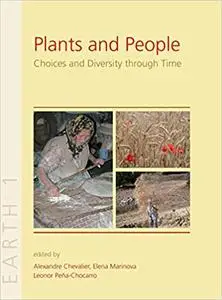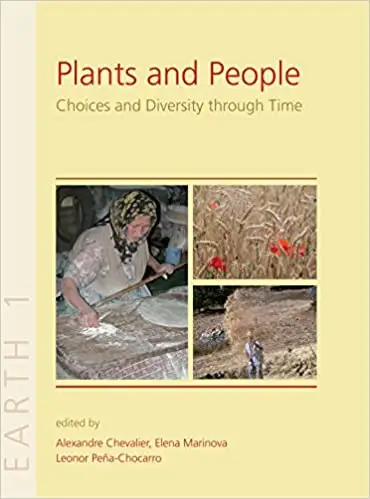Alexandre Chevalier, Elena Marinova, Leonor Pena-Chocarro, "Plants and People: Choices and Diversity through Time"
English | 2014 | ISBN: 1842175149 | EPUB | pages: 432 | 98.3 mb
English | 2014 | ISBN: 1842175149 | EPUB | pages: 432 | 98.3 mb
This first monograph in the EARTH: The Dynamics of Non-Industrial Agriculture: 8,000 years of Resilience and Innovation series, approaches the great variety of agricultural practices in human terms. It focuses on the relationship between plants and people, the complexity of agricultural processes and their organization within particular communities and societies. Collaborative European research among archaeologists, archaeobotanists, ethnographers, historians and agronomists using a broad analytical scale of investigation seeks to establish new common ground for integrating different approaches. By means of interdisciplinary examples, this book showcases the relationship between people and plants across wide ranging and diverse spatial and temporal milieus, including crop diversity, the use of wild foodstuffs, social context, status and choices of food plants.
Table of Contents
Preface, Patricia C. Anderson and Leonor Peña-Chocarro
Chapter 1: Introduction. Factors and issues in plant choice Alexandre Chevalier, Elena Marinova and Leonor Peña-Chocarro
Chapter 2: Exploring diversity in the past and in the present
2.1. Exploring Diversity in the Past: an Introduction Lydia Zapata
2.2. Exploring diversity through archaeobotany Linda Scott-Cummings
2.3. Exploring diversity through written sources José Luis Mingote-Calderón, Marie Russel and François Sigaut
2.4. Representing nature: images and social dynamics in ancient societies Susana González Reyero
2.5. Exploring diversity in the present: ethnobotany studies Gisella Cruz-García
2.6. Conclusions Lydia Zapata
Chapter 3: Crop diversity through time
3.1. Introduction Elena Marinova
3. 2. Crop diversity and choice in prehistoric southeastern Europe: cultural and environmental factors shaping the archaeobotanical record of northern Greece and Bulgaria Elena Marinova and Soultana-Maria Valamoti
3.3. Crop diversity between Central Europe and the Mediterranean: aspects of northern Italian agriculture Mauro Rottoli
3.4. Crop diversity in southwestern central Europe since the Neolithic Stefanie Jacomet
3.5. Crop diversity in the Neolithic of the Iberian Peninsula Leonor Peña-Chocarro and Lydia Zapata Peña
3.6. The choice of a crop and its underlying reasons: examples from western Central Europe 500 BCE – CE 900 Corrie Bakels
3.7. Crops and agricultural developments in Western Europe François Sigaut
3.8. Crop diversity and choice in the Prehistoric American Southwest Linda Scott Cummings
3.9. Processes of prehistoric crop diversification in the Lake Titicaca Basin of the South American Andes Maria C. Bruno
3. 10. Conclusions Elena Marinova
Chapter 4: Adding diversity. Between occasional food and speculative productions: diversity of fruit uses, diversity of practices regarding fruit tree cultivation
4.1. Introduction
4.2. Acorn use in Native California Rob Cuthrell
4.3. A wild solution to resilience and provision: The case of Prosopis spp. on the Peruvian north coast David John Goldstein
4.4. Before the Empire: prehistoric fruit gathering and cultivation in northern Italy Mauro Rottoli
4.5. Citrus (Rutaceae) was present in the western Mediterranean in Antiquity Bui Thi Mai and Michel Girard
4.6. From secondary to speculative production? The protohistorical history of viticulture in Southern France Laurent Bouby, Philippe Marinval and Jean-Frédéric Terral
4.7. Fruit as staple food: the role of fig (Ficus carica L.) during the pre-Hispanic period of the Canary Islands, Spain (from the 3rd–2nd centuries BCE to the 15th century CE) Jacob Morales and Jaime Gil
4.8. Beyond the divide between wild and domesticated: Spatiality, domesticity and practices pertaining to fig (Ficus carica L.) and olive (Olea europaea L.) agroecosystems among Jbala communities in northern Morocco Yildiz Aumeeruddy-Thomas, Younes Hmimsa, Mohammed Ater, and Bouchaïb Khadari
4.9. Conclusions Laurent Bouby
Chapter 5: Food plants from the wild
5.1 Introduction: Wild food plants in the present and past Gisella Cruz-García and Füsun Ertuğ
5.2. Gathering in a new environment: the use of wild food plants during the first colonization of the Canary Islands, Spain (2nd-3rd century BCE to 15th century CE) Jacob Morales and Jaime Gil
5.3. Wild food plants traditionally used in Spain: regional analysis Javier Tardío and Manuel Pardo-de-Santayana
5.4. The use of wild food plant resources in the Dogon country, Mali Camille Selleger
5.5. The silverweed: a food plant on the road from wild to cultivated? Cozette Griffin-Kremer
5.7. Conclusions Gisella Cruz-García and Füsun Ertuğ
Chapter 6: A versatile world: examples of diversity in plant use
6.1. Introduction Cozette Griffin-Kremer
6.2. “Humble plants”: uses of furze and nettles in the British Isles (and beyond) Cozette Griffin-Kremer
6.3. Versatile hulled wheats: farmers’ traditional uses of three endangered crop species in the western Mediterranean Leonor Peña-Chocarro and Lydia Zapata
6.4. The use of crop-processing by-products for tempering in earthen construction techniques Emmanuelle Bonnaire
6.5. Uses of the wild grass Ampelodesmos mauritanica in northwestern Tunisia today Patricia C. Anderson
6.6. The uses of the mastic tree (Pistacia lentiscus L.) in the west Mediterranean region: an example from Sardinia, Italy Maï Bui Thi, Michel Girard and François de Lanfranchi
6.7. Ancient and modern boat caulking: use of oleoresins in tropical Asia Maï Bui Thi and Michel Girard
6.8. Conclusions Cozette Griffin-Kremer
Chapter 7: Plants used in ritual offerings and in festive contexts
7.1. Introduction Ann-Marie Hansson and Andreas G. Heiss
7.2 Hidden Stone – a unique bread offering from an early medieval cremation grave at Lovö, Sweden Ann-Marie Hansson
7.3 Ceremonial foodstuffs from prehistoric burnt-offering places in the Alpine region Andreas G. Heiss
7.4 Festive use of plants: a diachronic glimpse of May Day in the British Isles, France and slightly beyond Cozette Griffin-Kremer
Common Plant Names, Now and Then – The Botanical Side of View Cozette Griffin-Kremer and Andreas G. Heiss
7.5 Ceremonial plants among the Hopi in North America Linda Scott Cummings
7.6 Ceremonial plants in the Andean region Matthew Sayre
7.7. Conclusions Andreas G. Heiss and Ann-Marie Hansson
Chapter 8: Social status, identity and contexts
8.1. Introduction Alexandre Chevalier
8.2. Plants for the ancestors: perpetuation of social status and justification of power in a Late Formative (400–100 BCE) Andean group Alexandre Chevalier and Jalh Dulanto
8.3. Plants in the Eastern Iberian Iron Age: from daily work to the ideological construction of the community Susana González Reyero
8.4. Social status and plant food diet in Bibracte, Morvan (Burgundy, France) Frédérique Durand and Julian Wiethold
8.5. Symbol of poverty? Children’s valuation of wild food plants in Wayanad, India Gisella Cruz-Garcia
8.6. More than simply fallback food? Social context of plant use in the northern German Neolithic Wiebke Kirleis and Stefanie Klooß
8.7. Legal constraints influencing crop choice in Castille and environs from the Middle Ages to the 19th century: some examples José Luis Mingote Calderón
8.8. Late Classic Maya provisioning and distinction in northwestern Belize David J. Goldstein and Jon B. Hageman
8.9. Conclusions Alexandre Chevalier
Chapter 9: Conclusions – Plants for thoughts Alexandre Chevalier, Leonor Peña-Chocarro and Elena Marinova
Plant name index



